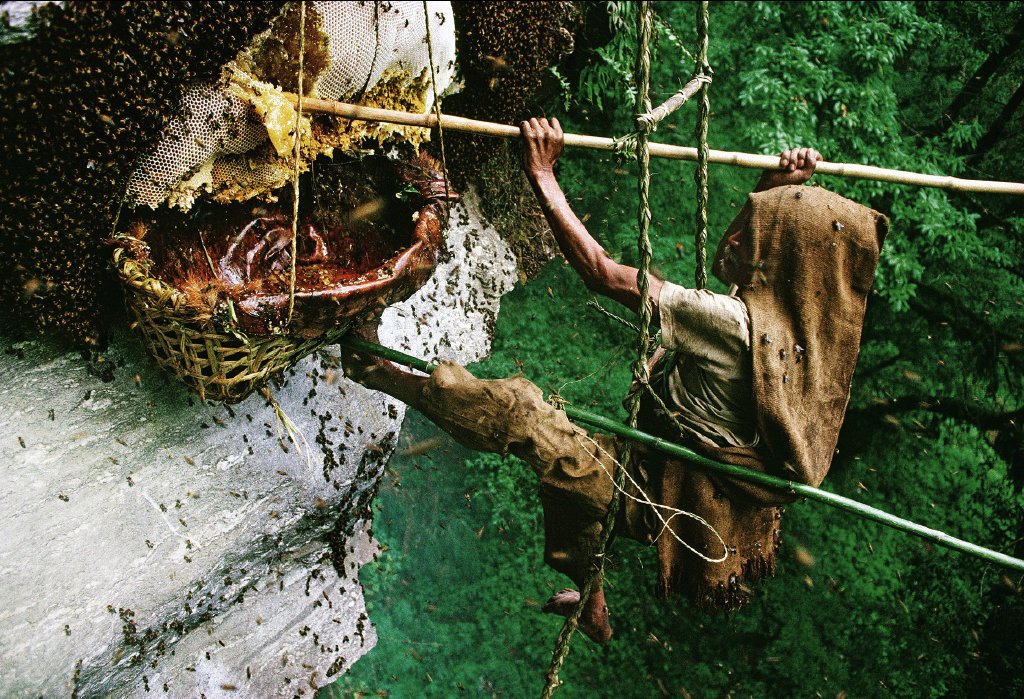
(Image mined from Wikipedia)
If you've read Seraphina's Lament, you know there is a part near the end of the book where "drugged honey" is used. Well, I'd completely forgotten about that scene until I started reading this book last night. I ran across this excerpt from an account told by Xenophon. It is as follows:
The numbers of beehives were indeed astonishing, and so were certain properties of the honey. The effect upon the soldiers who tasted the combs was, that they all went quite off their heads, and suffered from vomiting and diarrhea, with a total inability to stand steady on their legs. A small dose produced a condition not unlike violent drunkenness, a large attack very like a fit of madness, and some dropped down, apparently at death's door. So they lay, hundreds of them, as if there had been a great defeat, a prey to the cruelest despondency. But the next day, none had died; and almost at the same hour of the day at which they had eaten they recovered their senses, and on the third or fourth day got on their legs again like convalescents after a severe course of medical treatment.
Xenophon, an account of partaking of the honey of Trebizond on the Black Sea
In Seraphina's Lament the impact of this stuff is a bit more dramatic, a bit more paralyzing, a bit less drunken stupor. But there were a few reasons I chose this vehicle for his paralyzation at the end of the book. One was because of stories like this, where honey is recovered from thousands of years ago, and it's still good. Honey can last forever. According to Smithsonian Magazine, "But there’s something about honey; it can remain preserved in a completely edible form, and while you wouldn’t want to chow down on raw rice or straight salt, one could ostensibly dip into a thousand year old jar of honey and enjoy it, without preparation, as if it were a day old."
So Lyall could have this honey from thousands of years ago, and it would still be edible and usable an eon later, to fall prey to. This was an important consideration, considering the timeline differentiation between the old pantheon (Lyall, Dreshti, and others you'll meet in An Elegy for Hope) and the new ones that are "breaking" (Neryan, Seraphina, Vadden, Taub, Mouse, and Eyad). I needed something that could cross that span of years, and honey looked like it could be it.
But why does honey last?
The Smithsonian article boils it down, and if you want to really get into the nuts and bolts of why honey is so everlasting, I advise reading it. It's interesting. Suffice it to say, honey is extremely acidic, which basically kills off anything that tries to grow in it, and this:
Honey is, first and foremost, a sugar. Sugars are hygroscopic, a term that means they contain very little water in their natural state but can readily suck in moisture if left unsealed. As Amina Harris, executive director of the Honey and Pollination Center at the Robert Mondavi Institute at Univeristy of California, Davis explains, “Honey in its natural form is very low moisture. Very few bacteria or microorganisms can survive in an environment like that, they just die. They’re smothered by it, essentially.” What Harris points out represents an important feature of honey’s longevity: for honey to spoil, there needs to be something inside of it that can spoil. With such an inhospitable environment, organisms can’t survive long enough within the jar of honey to have the chance to spoil.
So, with all that taken into consideration, I decided honey would be the thing that would be used to use in my book. It could survive a span of thousands of years, it would still be edible, and he'd probably eat it and not be that suspicious because hey, it's honey. Who doesn't eat honey?
However, how did I get from run of the mill honey, to a honey that paralyzes? Reader, let me bring you into the really weird world that is the rhododendron.
Rhododendrons are insect pollinated. To sort of thank the insect for their time, these flowers produce a ton of sweet, sugary syrup. However, rhododendrons also produce a high level of something called Grayanotoxin. Grayanotoxin are toxic to many animals (and humans). The most common plants these toxins come from are Rhododendron luteum and Rhododendron ponticum. The honey from these plants is typically darker, and more reddish in color.
So what exactly does Grayanotoxin do?
According to The Apiarist, a small dose of honey made from bees that have foraged on rhododendron flowers can cause light-headedness and hallucinations. Larger doses can cause nausea, vomiting, paralysis, loss of consciousness, and can even stop your heart. Added to that, the honey causes blurred vision, dizziness, hypersalivation, perspiration, weakness and paresthesia in the extremities and around the mouth.
Apparently when you place honey with Grayanotoxin on your tongue, you'll feel a burning or prickling sensation. "There is also a reported Scottish case where a man licked rhododendron nectar from his hands and rapidly experienced paraesthesiae (‘pins and needles’), loss of coordination and an inability to stand, symptoms which resolved completely a few hours later." (The Apiarist)
There have been other accounts of honey toxicity. According to Gastro Obscura, in 69 AD, Pompey the Great's army fell into a very similar problem as the account I shared at the start of this post, in a similar region.
The Apiarist, an individual that hails from somewhere in the British Isles (I think Scotland) says that rhododendron are actually an invasive species on the west coast of the country, specifically around Snowdonia. The reason, however, this "mad honey" isn't such a problem there, is because the rhododendron in that area bloom while it is still cold, likely too cold for bees to thrive and collect much honey and become problematic.
According to our Apiarist friend, "Rhododendron is considered a major problem and grants are available for its removal. Estimated costs for eradication of rhododendron from Snowdonia and Argyll and Bute are £11M and £9.6M respectively"
In areas like Turkey and Nepal, however, the climate is very different, and "mad honey" can be bought online, and very easily. Further, the stuff has been used medicinally for a very long time. According to the Gastro Obscura article, the bees that collect this honey in Nepal create their hives on sheer cliffs, and the honey collectors who have to get this stuff end up climbing these cliffs to get the honey. It's very dangerous work, and accounts for the reason why, if you google this product, it's quite expensive.

(Image from here)
"Once the hunter is positioned, the bees are smoked out out, and the honeycombs are chiseled off the rock and caught by baskets that are then lowered onto the ground. Remember, the hunter is doing all of this on a rope ladder, with no protection, and with only angry bees and acrid smoke for company." (from this article)
However, in these regions, "mad honey" has been around for quite some time, and is commonly used not only for its hallucinogenic effects, but has also been touted for such uses as aiding hypertension, diabetes, and bowel disorders. Known as deli bal in Turkey, "mad honey" is thought to enhance sexual performance, and so is commonly sought after by men who seek to increase virility.
While the hallucinogenic effects have been proven time and time again, many of the other health claims haven't been... yet, though I believe scientists are studying this stuff. Aren't scientists always studying stuff like this?
Mad Honey isn't cheap. It's some of the most expensive honey in the world and is often sold on the black market in countries that have strict anti-drug laws.
Here's what a quick Google search showed me as a range of prices:

There have been no modern deaths associated to the honey, but there are recordings that span history about people using it, and being surprised by its effects, or using it explicitly for its effects.
And so, taking all of this into consideration, perhaps I changed the impact of this stuff a little in Seraphina's Lament, but I knew when I read about it, it was the perfect inspiration for the "drugged honey" that I needed for the book.
In today's world, I'm not sure it's something I'd ever want to eat, but it is interesting how one flower's honey can turn into something that can incapacitate an entire army.
Further reading:
The Apiarist
Smithsonian Magazine
Gastro Obscura
Botanical Curses and Poisons: The Shadow Lives of Plants

Comments
Post a Comment